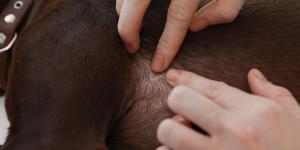Skin problems in animals
Learn more about skin problems in animals by exploring our site and become a true expert on the animal kingdom. You'll find content created for the best professionals with pictures, videos and opinions.
65 articles

New
New
White spots on a dog's skin can appear almost anywhere. We might see one or more white spots on their nose, lip, ear, paw or even their tongue. Location is very important in helping a veterinarian determine the cause of the white spot, but there are other factors to consider. We also need to look at the...

New
New
Feline sarcoma is a type of cancer which affects mesenchymal cells of various tissues. This means it can affect tissues such as bone and cartilage, but it is more common in the soft tissues such as fat and muscle. These sarcomas most commonly present as tumors and it is normally used to describe malignant cancers,...

One of the first things we notice about a dog is the color of their fur, but the color of their skin is not always very noticeable. In fact, too many guardians pay insufficient attention to a dog's skin. When a problem develops which leads to symptoms such as flaking, redness, swelling or the presence...

Melanoma in cats is a type of skin cancer that can also develop in the eyes, mucous membranes or mucocutaneous junctions. The latter is the transitional area between mucous membranes and skin. Although melanomas are always malignant in human medicine, we can find both benign and malignant melanoma in...

It is normal for a dog to have an odor we find quite pungent. Especially if they are wet, the natural oils on their skin mix with bacteria and other microorganisms to create a strong smell. Some dogs naturally smell worse than others, whether due to skin type or their natural hormone production. Unfortunately,...

Nasal cancer in cats, while not as common as some other feline cancers, can be a serious health concern. Nasal tumors are less common in cats than in dogs, making up about 1% of tumors in cats. However, these tumors can develop in various forms, from lymphoma to carcinomas, each requiring specific treatment...

Scabby and crusty ears on cats are relatively common, especially in feral felines. Being an extremity, they are more vulnerable to their environment and the dangers within it. These dangers include attacks from other animals, abrasions from foliage, opportunistic parasites and even the elements. While these...

Is your dog developing a hard lump under its skin? While finding a lump on your dog can be concerning, not all bumps are harmful. However, as a pet parent, you want to ensure any unusual changes in your dog's body receive proper attention. Understanding the causes, recognizing symptoms, and knowing when...

Dermatitis in cats is a common and troublesome skin condition marked by inflammation, itching, and often hair loss. This condition can stem from various factors, including environmental allergens, food sensitivities, parasitic infestations, bacterial or fungal infections, hormonal imbalances, and autoimmune...

Various types of tumors can appear on our dog's body. Although they can be completely benign, the fear of a malignant tumor is a call to action to achieve a quick diagnosis. This is the case with canine fibrosarcoma, a malignant tumor that affects the soft connective tissues of their body. It is a result...

Some guardians wonder if it is possible for dogs to get dandruff. Although its exact cause is poorly understood, dandruff is a condition whereby dead skin cells accumulate on and around hair. Humans get dandruff on their scalp due the greater number of sebaceous glands which mix with the dead skin cells...

Melanoma, a type of cancer developing from pigment cells, lurks in the shadows for many dogs. While not always aggressive, it can be a serious threat, particularly when left undetected. Knowing the early signs of melanoma in dogs is crucial, as prompt diagnosis and treatment significantly improve their...

Also known as pyotraumatic dermatitis in dogs, acute moist dermatitis is a skin infection which results in oozing inflamed patches of skin known as hot spots. The skin is exposed due to the hair loss in the area, a hair loss which is caused by the dog themselves. When a dog licks the same area repeatedly...

Dermatitis in dogs is a term which refers to the inflammation of a dog's skin, a symptom which has many causes. Whether due to infection, sensitivity, parasites or any other issue, dermatitis can be very troubling for the dog. Not only does it cause discomfort and pain, but the damaged skin is made vulnerable...

Canine hepatocutaneous syndrome (HCS) is an uncommon metabolic disorder impacting both the liver and skin. It exhibits distinct characteristics such as hepatopathy, hypoaminoacidemia, aminoaciduria, and superficial necrolytic dermatitis (SND), leading to specific crusted, red, and histologically unique...

Seeing your rabbit pull out its fur can be alarming for any pet owner. This behavior may be a sign of an underlying problem affecting your beloved companion. However, it is also possible that a rabbit with patches of fur missing in specific areas is simply engaging in a natural behavior. Nevertheless, it is...

Also known as scabies in horses, mange is a skin disease caused by the infestation of mites. It is a disease which is most associated with dogs. This is because the specific mite that causes sarcoptic mange in animals is Sarcoptes scabiei var. canis, a mite of the genus Sarcoptes which is highly contagious....

Cutaneous histiocytoma is a tumor that frequently occurs in young dogs less than 4 years of age. It is a tumor that appears in the form of reddish hairless nodules, generally in the head and neck area. Once they appear, the lesions grow rapidly, often causing great concern for caregivers. Despite their threatening...

Sebaceous cysts in dogs are benign lesions that frequently appear on the skin, especially in older animals. They are cavities surrounded by epithelium tissue that contains the fatty secretion of a sebaceous gland. Sebaceous cysts on dogs can look both painful and potentially harmful, but they are a...

Pododermatitis, commonly referred to as Fur Pad Dermatitis (FPD), is a condition that affects rabbits, primarily manifesting in the sensitive paw pads on their feet. This ailment is characterized by inflammation and dermatitis, often stemming from a combination of factors such as pressure, poor bedding,...

Commonly known as puppy strangles, juvenile cellulitis is a disease that is characterized by producing severe inflammation of the skin and lymph nodes of dogs. It is a rare, immune-mediated disease of unknown origin. Despite our lack of understanding concerning its causes, there are effective treatments...

Black discharge from a dog's ear can appear seemingly out of nowhere. We often first see there is a problem by repeated scratching of the area, something which can exacerbate the problem by opening wounds or introducing secondary bacteria. The initial agitation is often due to otitis, a general term for...

Also known as otohematomas, aural hematomas are an accumulation of bloody fluid in the ear. Specifically, the blood accumulates between the cartilage of the ear and the skin causing inflammation. There are various causes of feline aural hematoma, both primary and secondary. For example, a primary cause...

We may observe a cat cyst if we are petting them. When touching their fur, we might notice a subcutaneous lump, one of the most worrying such symptoms as it can imply the presence of cancer. Although this is possible, there are many types of cat cysts which can result in a lump or tumor, without being...

Scabs on a cat's skin can be due to various causes, but there are some which are more likely when the scabs appear on a cat's neck. A scab will occur once an open sore has started to heal since the hard crust is part of their immune response. Looking at the larger clinical picture will help us to understand...

Feline solar dermatitis is a pathology of the skin of our cats that arises as a result of frequent or continuous exposure to the sun. Also known as actinic dermatitis, it is especially prevalent in white cats and in those areas with less hair. The most affected area is the head, specifically the ears, eyes...

A bump on a dog's ear is likely due to an issue known as otohematoma in dogs. A type of ear hematoma, it can greatly vary in size, shape and texture, according to the individual dog. Not only do dogs use their ears to hear, but they are very important in maintaining balance. Any pathologies or other...

It is difficult to overstate the importance of proper footcare in our dogs. The skin on the plantar area of the paw pads is both resistant and sensitive. As dogs move, their paws come in contact with the ground which can be of various textures and materials. The paw pad itself is made up of fatty tissue...

A cat's wound should start to heal as soon as it occurs. The healing process is a part of the feline's natural defenses which is vital to sustain life after trauma and other threats to their health. While healing is something we often take for granted, for a cat's wound to heal properly many different processes...

Wound healing is a process which is affected by various factors. A serious of macroscopic, microscopic and molecular events need to occur for a dog's wound to heal properly. Tissue regeneration is a marvelous process which helps organisms survive, but is often a more delicate process than we would like...

Feline atopic dermatitis is a type of allergic response. When a cat has a hypersensitivity to a particular environmental allergen, they body reacts in an exaggerated way. These allergens can include dusts, mites, pollen or other common environmental stimuli. These allergens do not affect those without...

For many cats, it is normal to have a thinner patch of hair in the area between their eyes and the base of their ears. As with humans, it is also common for parts of their coat to become thinner as they age. Unlike humans, most cats have hair all over their body. Despite this fact, the area above the...

Warts may be easier to see on human skin, but cats are also susceptible to them. As with humans, warts on cats can have various underlying causes. They are generally benign skin growths, but the types of warts cats can develop are specific to the species. Many are related to the feline papillomavirus, but...

Calcinosis cutis is a disorder characterized by the lesions of calcium salts in the skin. The result is the appearance of hard nodules or crusted plaques. In the canine medicine, it usually appears in individuals with Cushing's syndrome or those subjected to prolonged treatment with corticosteroids. There...

While swelling and redness of a dog's paws can be observed at almost any stage, it is common for guardians to first become aware of this problem when we notice our dog keeps licking their paws. Whatever the underlying cause, swelling and redness is likely irritating for the dog. Licking their paws is a way...

Panniculitis is an inflammatory process that affects adipose tissue, the tissue we associate with body fat. It has multiple causes, both infectious and non-infectious. There are also many cases of idiopathic panniculitis in dogs where the etiology is unknown. The main clinical sign associated with panniculitis...

Ichthyosis is a skin disease that is known for its hardening of the skin. This seborrheic condition causes grey scales to appear, but it can result in secondary infections, blisters, onychogryphosis and hyperkeratosis.
It is a fortunately rare disease, but it does affect puppies more than adult dogs....

When your dog drags their butt against the floor, it can often be a very humorous sight. They sit down, raise their back legs and pull themselves along with their front paws. The pose they create and the often-strained face they make when doing so add to the picture. If this is a one-off experience, then...

It is common for caregivers to panic when they detect a lump on any part of a cat's body. Some ignore it for fear that it is some kind of skin cancer, but the truth is that not all lumps are synonymous with cancer. In any case, lumps can be curable so the soonest possible detection and treatment is essential.
In...

When kittens are born, they are not the same color they will be when they become adult. Even their eyes are not usually the same since all cats are born with blue eyes. Only later will different pigments develop. However, after 12 to 18 months most cats should be the color they will be for the rest of their...

We may not feel our dog's paws very often. Not only do we prefer to pet them on their fur, but generally dog's do not like their paws to be touched. However, it is very important we check on them regularly as injuries to their paws can cause pain, mobility issues and other problems. The skin on our...

Although rare, cats can suffer from autoimmune skin diseases which includes pemphigus foliaceus, pemphigus vulgaris, pemphigus erythematosus and paraneoplastic pemphigus.
In this AnimalWised article we're going to talk about autoimmune skin disease in cats, including the different types of pemphigus...

There is a key difference between a cat having floppy ears and a cat having one floppy ear. In the case of the former, the reason is likely due to their breed. Some cat breeds have been specially bred to promote ear shapes different from most other domestic cats. These include long eared cat breeds,...

A cat scratching itself is a normal and healthy behavior. If we had the dexterity of most cats, we'd be scratching just as much. As with any behavior, scratching excessively can cause serious harm. If a cat scratches itself raw, then wounds can develop which cause complications. Other reasons for a cat...

Purple spots on a dog's ear can be sign that they are suffering from vasculitis in dogs. Canine Vasculitis is the inflammation of a dog's blood vessels. This pathology affects not only the skin of the dog, but in some cases, other organs too. Although vasculitis in dogs is easy to define, is very difficult...

Skin diseases are one of the most frustrating pathologies for both dogs and their tutors. Apart from the obvious fact they jeopardize the health of the dog, they also reduce their quality of life. With sores, lesions, rashes and other symptoms of skin disease, the dog will often bite and scratch out of frustration....

Knowing the different skin disease which affect dogs is an essential part of their care. Identifying changes to the condition of their skin can mean early signs of serious conditions are treated promptly. Observation of the dog's guardian is crucial as this is the way we can bring an issue to the attention...

Hives in dogs, also referred to as Urticaria, can be defined as visible bulges on skin, in addition to noticeable reddened skin inflammation. Have you noticed your dog scratching more than normal? This, in addition to a swollen face, are common symptoms of hives in dogs.
For more aboutthe causes, symptoms,...

Fungi are very resistant organisms that can access an animal and/or human’s body through skin wounds, the respiratory tract or by ingestion. Sporothrix schenckii, for example, is a fungus which can cause sporotrichosis in cats. If not treated in time, it can be fatal. Itraconazole is one of the most...

Vitiligo in dogs is a rare condition with a relative lack of research in the area. Although not zoonotic or contagious, it is a skin condition which can also affect humans. Characterized by the development of white patches on the skin and hair, it is relatively uncommon. You might notice your dog gradually...
